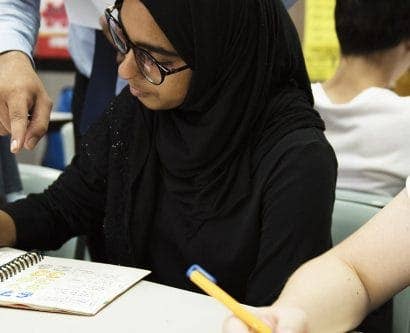What is Inclusive Practice?
All children should have an equal opportunity to succeed in education. This is regardless of their background, academic ability, and cognitive level. For a school community to be safe and welcoming, it must embrace and value diversity and individual differences.
Therefore, all schools should promote inclusive practice in both their teaching methods and educational activity. This article will focus on how this relates to early years and the benefits of adopting an inclusive approach.
What is Inclusive Practice?
Inclusive practice is a teaching approach that recognises the differences between students and uses this to ensure that all students can access educational content and participate fully in their learning. It understands that no two pupils are the same and ensures that lessons and activities accommodate this.
The approach also recognises the benefits that student diversity can bring to the overall learning experience. In fact, inclusive practice has a whole range of benefits for students as well as their teachers and families.
Some of the benefits of inclusive practice include:
- Teaching pupils about diversity and equality.
- Developing student empathy and sensitivity to people who are different from themselves.
- Improving friendships, confidence, and self-image.
- Providing teachers with additional ways to incorporate problem-solving, teamwork, and collaboration into their lessons.
- Promoting parental confidence that their children are being accepted and can be successful in the school setting.
While there are not necessarily any pieces of inclusive practice legislation, those who work with children should ensure that each child is treated equally. There have been publications in this area, such as The Equality Act 2010 and Schools, which explains that it’s unlawful to discriminate against any pupil because they possess one (or more) of the protected characteristics. Inclusive practice ensures that pupil diversity is accepted and championed, rather than discriminated against.

What is Inclusive Practice in Early Years?
If you work in education, you should understand both the inclusive practice definition and how you can apply it to your classroom. Promoting equality and diversity in childcare settings is essential for ensuring children grow up as accepting, well-rounded, and kind individuals. Adopting inclusive practices is the perfect way to demonstrate to children that you, and they, should strive towards equality.
Early years are a period of time when children are most in need of support. During these years, children are just beginning to learn fully about themselves, other people, and the world around them. They are discovering their identity and their place in the world. However, they are also at their most vulnerable within these years, particularly if they consider themselves to be ‘different’ from everyone else.
Inclusive practice ensures that all children receive equal opportunities, despite who they are. We’ve provided some examples to show what inclusive practice in early years might look like, and what you should do to achieve it.
Need a Course?
High Speed Training offer an online course on Equality and Diversity that can help you to understand your responsibilities for promoting equality and diversity in the workplace. You can also find a range of Safeguarding Children courses here.
Assess Your Teaching Methods
You should take the time to reflect on your teaching methods and practices and why you teach how you do.
Your educational background, upbringing, personality, likes and dislikes, and opinions all affect your identity and therefore, subconsciously, the way you teach.
Start to consider how your identity affects the way you act, how you deliver your lessons, and how you design and choose your resources. For example, do you read books at the start of every day because that’s what you did at school? Do you base your activities on what you think the children will enjoy? Think about how you plan your lessons, the reasons behind them, and whether they are equal and accessible for all students.

Examine Your Affinities and Prejudice
As well as assessing your teaching methods, you should think about any opinions that you might hold towards certain people or groups of people. This includes any empathy and prejudices that you might have. For example, you may have an affinity for a student who reminds you of your own child, or you may have a prejudice towards a child who reminds you of someone you previously taught.
Take the time to think about these things – they are often subconscious so may require some digging. Then, think about whether they are inclusive or if they are disadvantaging certain pupils.
Embrace Variety
Inclusive practice aims to ensure that all children can flourish in education, in spite of any challenges they face in their daily life. To make sure this is the case, you should use a variety of teaching methods and be flexible. For example:
- Working in pairs, groups, and individually.
- Working on computers and out of books.
- Making posters and other creative materials.
- Reading books.
- Story writing.
- Role play.
- Sporting activities.
- Musical activities.
By being flexible and using a variety of teaching methods, you are giving each student the opportunity to use their strengths and succeed. Additionally, you will help them to improve things that they find more challenging.

Adapt Your Content
Make your lessons diverse and adapt them towards your students. For example, if you have a new student who has just immigrated from Spain, you could spend some lesson time learning about Spanish culture, looking at pictures of Spanish monuments, and learning some Spanish words.
Aim to illustrate your points with examples that reflect the diversity of your students. For instance, using an example of a disabled child in one of your exercises. Ensure that you teach your class about different cultures, religions, countries, disabilities, and communities by including them in your day-to-day teaching.
Meet Your Students’ Needs
If you have disabled children in your classroom, or children with additional needs, then you will need to make reasonable adjustments for them. This basically means that you should remove or minimise disadvantages that they may face because of their condition.
This can include changing rooms or reading materials, for instance, or can be something much more specific. For example, regularly breaking up activities for a child with ADHD, allowing a break for a diabetic child to eat, or arranging a sporting activity that a child in a wheelchair can get involved in.
Inclusive practice is a teaching approach that recognises student diversity and uses this to ensure all children receive equal treatment, opportunities, and respect. Adopting inclusive practices is vital for ensuring that all children, despite their background or who they are, have an equal opportunity to succeed.
What to Read Next:
- Safeguarding Children in Education Quiz
- Mental Health Resource Pack for Schools
- Educational Bias: How to Avoid Bias in the Classroom
- What is Adaptive Teaching?
- How to Promote Equality, Diversity & Inclusion in the Classroom
- Safeguarding Children Training Courses











